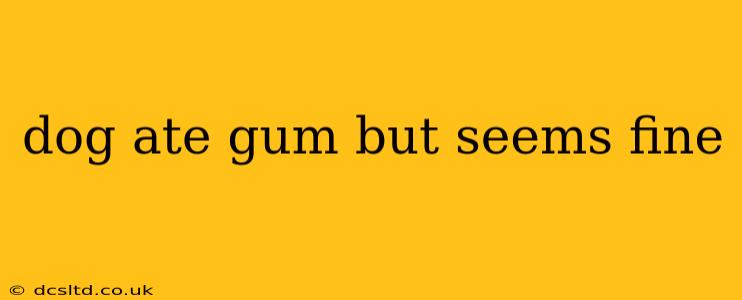Has your furry friend gotten into a sticky situation? Discovering your dog has eaten gum can be alarming, but thankfully, many dogs experience no adverse effects. However, it's crucial to understand the potential dangers and know when to seek veterinary attention. This comprehensive guide will walk you through everything you need to know about what to do if your dog ate gum, even if they seem fine right now.
What's the Big Deal About Gum?
The main concern with dogs ingesting gum isn't the flavoring or sweetness itself; it's the xylitol and the artificial sweeteners. Xylitol, a sugar alcohol commonly found in sugar-free gum, is incredibly toxic to dogs. Even small amounts can trigger a rapid and dangerous drop in blood sugar (hypoglycemia), leading to liver failure in severe cases. Artificial sweeteners, while less immediately dangerous than xylitol, can still cause gastrointestinal upset.
The other major concern is the gum base itself. This sticky substance is difficult for dogs to digest and can cause intestinal blockages, especially if a large amount is consumed. The longer the gum base stays in the system, the greater the risk of complications.
My Dog Ate Gum, But Seems Fine: What Should I Do?
While your dog might appear fine immediately after ingesting gum, it's vital to monitor them closely for at least the next 24 hours. Even if no symptoms appear immediately, the effects of xylitol can be delayed.
Here's a crucial checklist:
- Identify the gum: Try to determine if the gum was sugar-free (containing xylitol) or regular. Knowing this significantly impacts the urgency of the situation.
- Note the amount: Estimate how much gum your dog ate. A small piece of regular gum is less concerning than a large quantity of xylitol-containing gum.
- Observe your dog: Watch for symptoms like vomiting, diarrhea, weakness, lethargy, tremors, seizures, or difficulty breathing. These are all potential indicators of xylitol poisoning or intestinal blockage.
- Contact your veterinarian: Even if your dog appears healthy, it's best to contact your vet. They can assess the situation, considering the type and amount of gum ingested, and advise on the best course of action. They might recommend inducing vomiting or monitoring your dog closely for the next few hours.
What are the Symptoms of Xylitol Poisoning in Dogs?
Understanding the symptoms is key to swift action. Here are some common signs of xylitol poisoning:
- Weakness and Lethargy: Your dog might seem unusually tired or sluggish.
- Vomiting: This is a common response to a foreign substance in the stomach.
- Diarrhea: This could be an indicator of gastrointestinal distress.
- Tremors and Seizures: These are more severe symptoms requiring immediate veterinary attention.
- Difficulty Breathing: This is a critical symptom signifying potential respiratory distress.
- Coma: In severe cases, xylitol poisoning can lead to a coma.
How Long Does it Take for Xylitol to Affect a Dog?
The onset of symptoms after xylitol ingestion can vary. Some dogs show signs within 30 minutes, while others might not exhibit symptoms for several hours. This is why continuous monitoring is crucial.
Can I Make My Dog Throw Up?
Do not induce vomiting at home unless specifically instructed by your veterinarian. Some methods of inducing vomiting can be dangerous and could worsen the situation. Your vet will advise on the safest and most effective approach if needed.
What if My Dog Ate a Small Amount of Regular Gum?
If your dog ate a small amount of regular gum (not containing xylitol), they might experience mild gastrointestinal upset. Observe them for any signs of discomfort and contact your vet if you have any concerns. However, the risk is significantly lower compared to xylitol-containing gum.
Preventing Future Incidents: Keeping Gum Out of Reach
The best way to deal with this situation is to prevent it from happening in the first place. Keep all gum, especially sugar-free varieties, out of your dog's reach. Store it in cabinets or high places inaccessible to curious canine companions.
By understanding the risks and acting promptly, you can ensure your dog's safety and well-being. Remember, early intervention is key when dealing with potential xylitol poisoning. Always err on the side of caution and consult your veterinarian if you suspect your dog has ingested gum.
